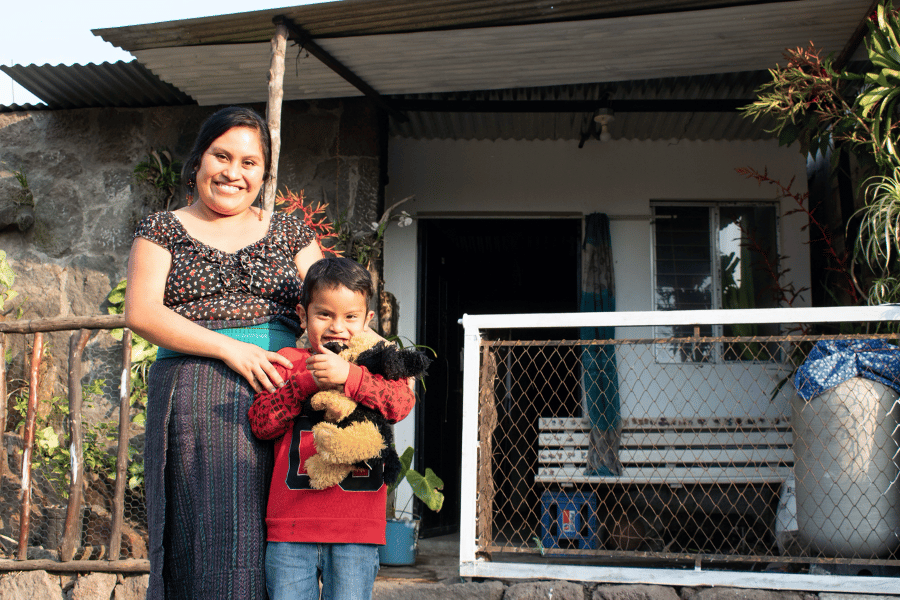Girls Belong
Here
By: Obii, Girls Belong Here participant
Reading time: 6 minutes

Issues related to infrastructure and homeownership resonate deeply with me, and it meant the world to me to be able to voice my concerns on the issue of sustainability within Canada’s homeownership model.
In her own words, Grade 11 student Obii, 17, shares what she learned during a virtual seat share at Habitat for Humanity through Plan International Canada’s Girls Belong Here program.
Making Connections
I first heard about Plan International Canada while searching online for opportunities to get involved in youth advocacy. I contacted Youth Engagement manager Zein Hindawi to see if Plan International Canada could help me raise awareness for a bottle drive I was organizing for newcomer women and children in Saskatoon, where I live. The funds would be used to help support newcomers from around the world, including Afghanistan, Syria, Iraq, Bangladesh and Nigeria. Plan agreed to help and featured me as a changemaker in their monthly youth newsletter.
Supporting this cause is an important issue close to my heart because I grew up as a second-generation Canadian. My parents immigrated to Canada from Nigeria, and I was fortunate to have a stable upbringing and parents who always provided for me.
But I saw other families around us who had a lot of difficulties integrating into Canadian society. Even in my family, there are cultural differences between being Canadian and being Nigerian. For instance, Nigerians are known to be outspoken and brash. My mother has always taught me to make sure I was always better than the best, in order to assimilate or fit in – based on the barriers I face because of the colour of my skin.
Learn more about our Girls Belong Here program:
learn more





I eventually applied for the Girls Belong Here program, and after being accepted, I was assigned a virtual seat share at Habitat for Humanity Canada, due to my keen interest in architecture and housing in Canada.
The Girls Belong Here initiative at Plan International Canada is part of a global movement to amplify girls’ voices, advocate for their rights and elevate their position in society. To date, the program has helped connect nearly 200 female-identifying and gender-diverse youth with businesses, governments and not-for-profit organizations to demonstrate that girls belong at all levels of leadership.
Virtual Seat Share
When I signed on to the virtual seat share at the Habitat Canada office in Toronto last February, I was extremely nervous but excited to learn.
I wanted to meet as many people as possible, particularly Julia Deans, the CEO and president of Habitat Canada. And thankfully, throughout the experience, I was granted the opportunity not only to listen to everybody’s thoughts on affordable homeownership in Canada but also to share my thoughts on the subject as well.
Issues related to infrastructure and homeownership resonate deeply with me, and it meant the world to me to be able to voice my concerns on the issue of sustainability within Canada’s homeownership model.


Obii (bottom centre) participated in a virtual seat share with the Girls Belong Here program last spring and got to spend the day with Habitat for Humanity CEO Julia Deans (top left) and former Plan International Canada graphic designer Bianca Jozwiak (top right).

Week to Dream
The idea of doing a seat share with such high-profile and accomplished individuals like Julia Deans and Sarah Varley, Habitat’s vice president of communications and partnerships, would be daunting for almost anybody, and I was no exception.
But still, I’d encourage youth to sign up for Girls Belong Here and spend a day in a setting with people who do what you dream of doing one day. It’s the best way to learn and the most powerful way to understand if the work is truly in line with your own dreams.
There is an old saying that you should never meet your heroes, but I’m so glad I did. When Julia Deans told me, “Keep pushing forward,” it really made an impression on me, because it helped motivate me to sustain the personal progress I have been working on ever since my interest in architecture began. I’m hoping to apply for a co-op placement next year.
P.S. My bottle drive, which took place in May 2022, went extremely well. I raised more than $500, with all of the money donated to the International Women of Saskatoon, a non-profit organization that supports immigrant and refugee women.
Habitat for Humanity Canada has participated in GBH for three consecutive years because the benefits are clear to both the youth participant and the organization.
“It gives us a mirror to see ourselves through the participant's eyes. It’s been really wonderful for us and our team,” says Deans. “We can explore some of the young women’s perceptions of what leadership is and what leaders have to do to be successful.”
Deans says she often gains a fresh, young perspective about her organization after participating in the seat share, and she says it’s equally rewarding to know that she is opening a new networking opportunity to the youth participant.
A volunteer with Habitat for Humanity Canada helps build a home in a First Nation in southern Ontario.




Habitat for Humanity participants from Guatemala.

Three women who are part of the Habitat for Humanity organization pose together in front of a house in Malawi.

I admire Habitat Canada greatly because of the pure integrity of its initiative to bring communities together. I also respect the team’s efforts to accommodate the needs of underserved low-income and racialized communities.
The organization runs the Habitat for Humanity ReStore, a social enterprise retailer that resells donations of new and used furniture, appliances, decore and building materials. In addition to the sustainable practices of the ReStore, all profits from their operations fund Habitat for Humanity, which allows for more homes to be built to support underserved communities (including Black and Indigenous communities across Canada).
I learned that the organization prioritizes Indigenous housing projects and focuses on reconciliation through the Indigenous Housing Partnership, an equitable partnership rooted in respect for Indigenous culture, with a primary goal of delivering housing solutions by Indigenous communities for Indigenous communities.
Learn more about the Girls Belong Here program and how you can enrol as an organization or a participant
-Obii

Learn more about our 2023 Girls Belong Here program and the impact
these connections are having on youth and female leaders.

Youth participant Candice Zhong spent the day at Pfizer headquarters
in Toronto as part of the Girls Belong Here program.

The organization works in other countries to provide sustainable housing and infrastructure projects in Africa, the Middle East, Asia, Latin America and the Caribbean.
One specific example I remember is the homebuilding model of creating latrines in communities without access to running water and providing residents with adequate plumbing systems.
My virtual seat share took place over five days and was filled with interesting meetings, starting with executive introductions. Then I was given time to ask questions about the topics close to my heart: sustainability, building codes, climate change and the future of affordable housing in Canada.
Girls Belong Here 2023 participants with Plan International Canada CEO Lindsay Glassco (centre in blue).
I’ve always wanted to become an architect, as I love design and planning because of the limitless possibilities they present, and the seat share was the perfect opportunity to develop and explore my passion of providing sustainable housing for newcomers to Canada.




